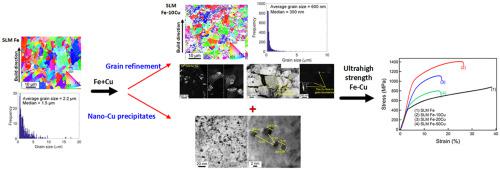Additive Manufacturing ( IF 10.3 ) Pub Date : 2021-08-30 , DOI: 10.1016/j.addma.2021.102270 A. Zafari 1 , K. Xia 1

|
Laser powder bed fusion (LPBF) was employed to produce Fe and Fe-(10–50 vol%) Cu immiscible alloys using elemental powders. The addition of 10 vol% Cu to Fe resulted in ultrahigh compressive yield and ultimate strengths of >~ 1000 and ~ 1400 MPa (more than 2 times greater than those in LPBF Fe and 4–6 times than in conventionally processed Fe), respectively, with fracture strain of ~ 20%. However, a further increase in the amount of Cu gave rise to significantly more heterogeneous microstructures with non-uniform distribution of Cu, leading to considerable liquation cracking, large voids and reduced strength and plasticity. Strengthening was primarily attributable to the dispersion of nano-Cu particles of 2–5 nm with spacings of < 10 nm and ultrafine grains (<~ 50–300 nm). The substantial grain refinement in Fe-Cu alloys during LPBF was mainly a result of the confinement of Fe crystals by Cu films, hindering their growth. By analysing microstructures in single laser tracks, single layers, top and middle sections of the LPBF Fe, it was revealed that constitutional undercooling during solidification or the subsequent transformations of γ → α were responsible for the formation of equiaxed, rather than columnar, grains in pure Fe.
中文翻译:

使用元素粉末的超高强度 Fe-Cu 合金的激光粉末床熔合
激光粉末床融合 (LPBF) 用于使用元素粉末生产 Fe 和 Fe-(10–50 vol%) Cu 不混溶合金。在 Fe 中添加 10 vol% Cu 导致超高的压缩屈服强度和极限强度 >~1000 和 ~1400 MPa(分别是 LPBF Fe 的 2 倍以上和常规加工的 Fe 的 4-6 倍),断裂应变约为 20%。然而,铜含量的进一步增加会导致显着更多的非均匀微观结构和铜的不均匀分布,导致相当大的液化开裂、大空隙以及强度和塑性降低。强化主要归因于 2-5 nm 纳米铜颗粒的分散,间距 < 10 nm 和超细晶粒 (<~ 50-300 nm)。Fe-Cu 合金在 LPBF 过程中的显着晶粒细化主要是由于 Cu 膜对 Fe 晶体的限制,阻碍了它们的生长。通过分析 LPBF Fe 的单个激光轨迹、单层、顶部和中间部分的微观结构,发现凝固过程中的结构过冷或随后的 γ → α 转变是形成等轴晶粒而非柱状晶粒的原因。纯铁。











































 京公网安备 11010802027423号
京公网安备 11010802027423号